International Journal of Intelligent Systems and Applications @ijisa
Статьи журнала - International Journal of Intelligent Systems and Applications
Все статьи: 1203
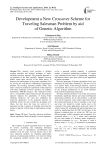
Development a New Crossover Scheme for Traveling Salesman Problem by aid of Genetic Algorithm
Статья научная
This research work provides a detailed working principle and analysis technique of multi- offspring crossover operator. The proposed approach is an extension of the basic partially- mapped crossover (PMX) based upon survival of the fittest theory. It improves the performance of the genetic algorithm (GA) for solving the well-known combinatorial optimization problem, the traveling salesman problem (TSP). This study is based on numerical experiments of the proposed with other traditional crossover operators for eighteen benchmarks TSPLIB instances. The simulation results show a considerable improvement because the proposed operator enhances the opportunity of having better offspring. Moreover, the t-test also establishes the improved significance of the proposed operator. Its preferable results not only confirm the advantages over others, but also show the long run survival of a generation having a number of offspring more than the number of parents with the help of mathematical ecology theory.
Бесплатно
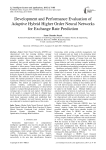
Статья научная
Higher Order Neural Networks (HONN) are characterized with fast learning abilities, stronger approximation, greater storage capacity, higher fault tolerance capability and powerful mapping of single layer trainable weights. Since higher order terms are introduced, they provide nonlinear decision boundaries, hence offering better classification capability as compared to linear neuron. Nature-inspired optimization algorithms are capable of searching better than gradient descent-based search techniques. This paper develops some hybrid models by considering four HONNs such as Pi-Sigma, Sigma-Pi, Jordan Pi-Sigma neural network and Functional link artificial neural network as the base model. The optimal parameters of these neural nets are searched by a Particle swarm optimization, and a Genetic Algorithm. The models are employed to capture the extreme volatility, nonlinearity and uncertainty associated with stock data. Performance of these hybrid models is evaluated through prediction of one-step-ahead exchange rates of some real stock market. The efficiency of the models is compared with that of a Radial basis functional neural network, a multilayer perceptron, and a multi linear regression method and established their superiority. Friedman's test and Nemenyi post-hoc test are conducted for statistical significance of the results.
Бесплатно
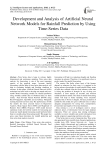
Статья научная
Time Series data is large in volume, highly dimensional and continuous updating. Time series data analysis for forecasting, is one of the most important aspects of the practical usage. Accurate rainfall forecasting with the help of time series data analysis will help in evaluating drought and flooding situations in advance. In this paper, Artificial Neural Network (ANN) technique has been used to develop one-month and two-month ahead forecasting models for rainfall prediction using monthly rainfall data of Northern India. In these model, Feed Forward Neural Network (FFNN) using Back Propagation Algorithm and Levenberg- Marquardt training function has been used. The performance of both the models has been assessed based on Regression Analysis, Mean Square Error (MSE) and Magnitude of Relative Error (MRE). Proposed ANN model showed optimistic results for both the models for forecasting and found one month ahead forecasting model perform better than two months ahead forecasting model. This paper also gives some future directions for rainfall prediction and time series data analysis research.
Бесплатно
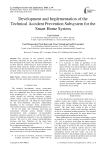
Статья научная
The structure of the technical accident prevention subsystem for the smart home system has been developed in the article. The subsystem model based on Petri network, model based on neural network and physical model using the Arduino microcontroller have been realized in the development process. The subsystem research results with the use of the developed models, soft- and hardware tools are also presented.
Бесплатно
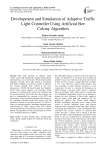
Статья научная
This paper proposes an adaptive traffic control system that dynamically manages traffic phases and durations at cross-intersection. The developed model optimally schedules green light timing in accordance with traffic condition on each lane in order to minimize the Average Waiting Time (AWT) at the cross intersection. A MATLAB based Graphic User Interface (GUI) traffic control simulator was developed. Three scenarios of vehicular traffic control were simulated and the results presented. The results show that scenario one and two demonstrated the variation of the AWT and Performance of the developed algorithm with changes in the maximum allowable green light timing over the simulation interval. In the third scenario, an AWT of 38sec was recorded against a maximum allowable green light duration of 120sec, during which 1382 vehicles were evacuated from the intersection, leaving 22 vehicles behind. The algorithm also had a performance of 98.43% over a simulation duration of 1800sec.
Бесплатно
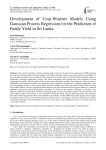
Статья научная
This research introduces machine learning models using the Gaussian Process Regression (GPR) depicting the association between paddy yield and weather in Sri Lanka. All major regions in the island with most contribution to the total paddy production were considered in this research. The climatic factors of rainfall, relative humidity, minimum temperature, maximum temperature, average wind speed, evaporation, and sunshine hours were considered as input (independent) variables, while the paddy yield was the output (dependent) variable. The collinearity within each pair of independent and dependent variables was determined using Spearman’s and Pearson’s correlation coefficients. Data sets corresponding to the two main annual paddy cultivation seasons since 2009 were trained in MATLAB to develop crop-weather models. The most appropriate Kernel function was chosen from among four types of Kernels viz. Rational Quadratic, Exponential, Squared Exponential, and Matern 5/2 based on their degree of coherence in modeling. This approach exploits the full potential of GPR in developing highly accurate crop-weather models. The performance of the crop-weather models was measured by the Correlation Coefficient, Mean Absolute Percentage Error, Mean Squared Error, Root Mean Squared Error Ratio, Nash Number and the BIAS. All the GPR-based models proposed in this paper are highly accurate in terms of the aforementioned evaluation metrics. Accordingly, when the climatic data are known or projected, the paddy yield and thereby the harvest of Sri Lanka can be predicted precisely by using the proposed crop-weather models.
Бесплатно
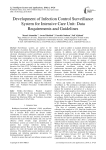
Статья научная
Surveillance systems are useful in the identification of patients that contract infections during their hospitalization period. Despite still being at infancy, electronic information control surveillance systems for Hospital Acquired Infections (HAIs) are improving and becoming more commonplace as the acceptance levels rise. There are crucial gaps in existing knowledge concerning the best ways for implementing electronic surveillance systems especially in the context of the Intensive Care Unit (ICU). To bridge this gap, the aim of this paper was to provide a comprehensive review of various electronic surveillance approaches and to highlight the requisite data components and offer guidelines. This review revealed denominator, numerator, and discrete data requirements and guidelines for the surveillance of four main ICU HAIs, including Central Line–Associated Bloodstream Infection (CLABSI), Urinary Tract Infection (UTI), Surgical Site Infections (SSIs) and Ventilator-Associated Conditions/Events (VACs/VAEs).
Бесплатно
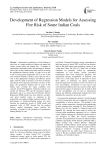
Development of Regression Models for Assessing Fire Risk of Some Indian Coals
Статья научная
Spontaneous combustion of coals leading to mine fires is a major problem in Indian coal mines that creates serious safety and mining risk. A number of experimental techniques based on petrological, thermal and oxygen avidity studies have been used for assessing the spontaneous heating liability of coals all over the world. Crossing point temperature (CPT) is one of the most common methods in India to assess the fire risk of coal so that appropriate strategies and effective action plans could be made in advance to prevent occurrence and spread of fire and hence minimize coal loss. In this paper, the spontaneous heating risks of some of the Indian coals covering few major coalfields were assessed using CPT apparatus. Statistical analysis was carried out between CPT and the proximate analysis parameters and it was found that the Mixture Surface Regression (MSR) model was more effective and gave very good residual values as compared to the polynomial and simple multiple regression models. The performance of Anderson-Darling testing was done between the prediction results of MSR model and measured value of CPT showed that the residual follows normal distribution hence justifies the suitability of model for the prediction of spontaneous heating liability of coal.
Бесплатно
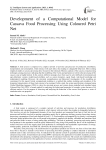
Development of a Computational Model for Cassava Food Processing Using Coloured Petri Net
Статья научная
A food system is composed of a complex network of activities and processes for production, distribution, transportation and consumption, which interact with each other, thus leading to changeable behaviour. Most existing empirical studies on cassava processing have focused on the technical efficiency analysis of the cassava crop processing techniques among processors indicating that the modelling of the events and operations involved in the processing of the cassava crop is highly limited. In this context, different strategies have been used to solve difficult environmental and agro-informatic systems model-based problems such as system dynamics, agent based, rule-based knowledge and mathematical modeling. However, the structural comprehension and behavioral investigation of this modeling are constrained. In this regard, formal computational modeling is a method that enables modeling and simulation of the dynamical characteristics of these food systems to be examined. In this study, the system specification is designed using Unified Modelling language (UML) to show the structural process and system design modelled and simulated using Coloured Petri Net (CPN), a formal method for analyzing the behavioural properties of complex system because of its efficient analysis. For the purpose of observing and analyzing the behaviour of the cassava food process, a series of simulation runs was proposed.
Бесплатно
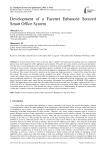
Development of a Facenet Enhanced Secured Smart Office System
Статья научная
A secured smart office system is the one that is capable of recognizing and granting access to authorized persons only and manage the office appliances autonomously. The goals are access control, security and automation. Over the years, several studies have been carried out to meet these needs using RFID cards, access codes and biometrics resulting in weak security with long computational period. Switching of electrical appliances and smoke detection in case of fire outbreak were used but real time electrical appliances management that could prevent fire outbreak is yet to be achieved. This research focused its attention on the design and implementation of a smart office system that meet these needs. The system was developed using a raspberry pi 4 board. Ultrasonic sensor, camera, servo motor, relay, current and voltage sensors were interfaced with the raspberry pi for image capturing, opening the door, switching and power monitoring respectively. The system captures the image of an approaching person and process it for recognition using FaceNet; an open source model for face recognition. Information was transmitted via SIM800L GSM module as SMS to the administrator. The system shuts down the office electrical network once the supply voltage exceeds 220v ac or less than 161v ac, thus preventing any chance of fire outbreak due to irregular power supply. The accuracy of image recognition model was 93.13%. This research has shown a simple way of implementing an autonomous smart office system that is capable of providing adequate security, efficiency and convenience in offices.
Бесплатно
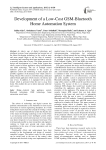
Development of a Low-Cost GSM-Bluetooth Home Automation System
Статья научная
In today's age of digital technology and intelligent systems, home automation has become one of the fastest developing technology in the world as more and more people begin to see the idea of remotely monitoring and controlling their home appliances more as a necessity rather than a luxury. This paper presents the design and development of a smart home system that allows control of home appliances using both Bluetooth and GSM technology. The use of multiple control mediums gives more robustness to the system as appliance control and monitoring is made cheaper and possible regardless of the distance from which control is being effected. The system is controlled using a dedicated android based application which ensures convenience and ease of use. In addition, it is equipped with a security feature which is activated when the user is away from home. This enables the user to detect intrusion while the user is away.
Бесплатно
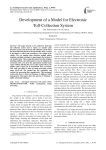
Development of a Model for Electronic Toll-Collection System
Статья научная
The paper presents a new method for electronic toll collection system and to match car number plate detection system. The electronic toll collection system (ETS) has been fabricated based on microcontroller. Here a system is developed to collect tolls according to the weight of the vehicle. The car number plate detection method utilizes template matching technique to approximate the location of car number plate. Then, using this output from the template matching method, color information is used to eliminate the unwanted color areas from the approximate number plate region without affecting the correct color regions. Hence, the number plate region can be determined more accurately. This work can easily be done by image processing system using MATLAB. The method has low complexity and reduced the processing time magnificently. This automated system also shows a better performance in highway traffic management. This paper shows the gateway to fabricate a highly automated toll-plaza.
Бесплатно
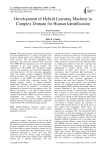
Development of hybrid learning machine in complex domain for human identification
Статья научная
This paper presents a hybrid learning machine for human identification. It is a merger of eigenface with fisherface method, genetic fuzzy clustering and complex neural network. The non-linear aggregation based summation and radial basis function neural networks (NLA-SRBF NNs) are proposed as one of the functional component of the novel learning machine. The architecture of NLA-SRBF NNs incorporates hidden neurons, with summation and radial basis aggregation, and output neurons with only summation aggregation, along with complex resilient propagation (ČRPROP) learning procedure. The improved learning and speedy convergence of NLA-SRBF NN enables the hybrid machine to provide better recognition accuracy. The learning machine consists of feature extraction, unsupervised clustering and supervised classification module. The aim of our proposal is to enhance the performance of biometric based recognition system. The efficacy and potency of our hybrid learning machine demonstrated on three benchmark biometric datasets-extended Cohn-Kanade, FERET and AR face datasets to comprehend the motivation. The performance comparisons of different variations of hidden neuron and learning algorithm thoroughly presented the superiority of the proposed NN based hybrid learning machine.
Бесплатно
Статья научная
In computer vision, face tracking is having wider opportunities for research activities using different background video sequences because of various factors and constraints. Due to the challenges that are increasing day by day, old/existing algorithms are becoming obsolete. There are many powerful algorithms that are limited to certain set of video sequences. In this paper, we are proposing an algorithm that detect and track multiple faces in different background video sequences. Viola-Jones face detection algorithm is used in such a way that, new face/first face need not to be in the starting frame of the selected video sequence. The proposed algorithm successfully detect new face(s) along with existing face(s) by keeping track of the facial data using BRISK feature points. The mean of the old points and new points are calculated based on the area of the facial data. The detected face(s) in further frames undergoes similarity check with existing facial data. If detected facial data and existing facial data mismatches, then the detected facial data is entered into face tracks structure. By using point tracker method, the proposed algorithm track those points that has been set for each of the facial data.
Бесплатно
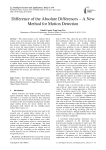
Difference of the Absolute Differences – A New Method for Motion Detection
Статья научная
This article presents a new method, which reduces costs and processing time for spatial object motion detection by focusing on the bare-hand motion that mimics computer mouse functions to allow the user to move the mouse pointer in real-time by the motion of his/her hand without any gloves worn, any object carried, or any key hit. In this article, the study of this topic is from the viewpoint of computer vision and image processing. The principals of the difference of the absolute differences (DAD) are investigated. A new method based on the DAD principles, which is conceptually different from all the existing approaches to spatial object motion detection, is developed and applied successfully to the bare-hand motion. The real-time implementation of the bare-hand motion detection demonstrates the accuracy and efficiency of the DAD method.
Бесплатно
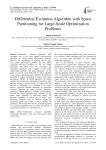
Differential Evolution Algorithm with Space Partitioning for Large-Scale Optimization Problems
Статья научная
Differential evolution algorithm (DE) constitutes one of the most applied meta-heuristics algorithm for solving global optimization problems. However, the contributions of applying DE for large-scale global optimization problems are still limited compared with those problems for low and middle dimensions. DE suffers from slow convergence and stagnation, specifically when it applies to solve global optimization problems with high dimensions. In this paper, we propose a new differential evolution algorithm to solve large-scale optimization problems. The proposed algorithm is called differential evolution with space partitioning (DESP). In DESP algorithm, the search variables are divided into small groups of partitions. Each partition contains a certain number of variables and this partition is manipulated as a subspace in the search process. Selecting different subspaces in consequent iterations maintains the search diversity. Moreover, searching a limited number of variables in each partition prevents the DESP algorithm from wandering in the search space especially in large-scale spaces. The proposed algorithm is tested on 15 large- scale benchmark functions and the obtained results are compared against the results of three variants DE algorithms. The results show that the proposed algorithm is a promising algorithm and can obtain the optimal or near optimal solutions in a reasonable time.
Бесплатно
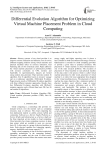
Differential evolution algorithm for optimizing virtual machine placement problem in cloud computing
Статья научная
Primary concern of any cloud provider is to improve resource utilization and minimize cost of service. Different mapping relations among virtual machines and physical machines effect on resource utilization, load balancing and cost for cloud data center. Paper addresses the virtual machine placement as optimization problem with resource constraints on CPU, memory and bandwidth. In experimentations, datasets are formed using random data generator. Paper presents random fit algorithm, best fit algorithm based on resource wastage and an evolutionary algorithm- Differential Evolution. Paper presents results of Differential Evolution algorithm with three different mutation approaches. Results show that Differential Evolution algorithm with DE/best/2 mutation operator works efficient than basic DE, best fit and random fit algorithms.
Бесплатно
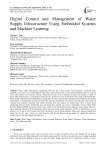
Статья научная
Water supply infrastructure operational efficiency has a direct impact on the quantity of portable water available to end users. It is commonplace to find water supply infrastructure in a declining operational state in rural and some urban centers in developing countries. Maintenance issues result in unabated wastage and shortage of supply to users. This work proposes a cost-effective solution to the problem of water distribution losses using a Microcontroller-based digital control method and Machine Learning (ML) to forecast and manage portable water production and system maintenance. A fundamental concept of hydrostatic pressure equilibrium was used for the detection and control of leakages from pipeline segments. The results obtained from the analysis of collated data show a linear direct relationship between water distribution loss and production quantity; an inverse relationship between Mean Time Between Failure (MTBF) and yearly failure rates, which are the key problem factors affecting water supply efficiency and availability. Results from the prototype system test show water supply efficiency of 99% as distribution loss was reduced to 1% due to Line Control Unit (LCU) installed on the prototype pipeline. Hydrostatic pressure equilibrium being used as the logic criteria for leak detection and control indeed proved potent for significant efficiency improvement in the water supply infrastructure.
Бесплатно
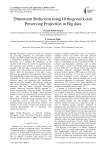
Dimension reduction using orthogonal local preserving projection in big data
Статья научная
Big Data is unstructured data that overcome the processing complexity of conventional database systems. The dimensionality reduction approach, which is a fundamental technique for the large-scale data-processing, try to maintain the performance of the classifier while reduce the number of required features. The pedestrian data includes a number of features compare to the other data, so pedestrian detection is the complex task. The accuracy of detection and location directly affect the performance of the entire system. Moreover, the pedestrian based approaches mainly suffer from huge training samples and increase the computation complexity. In this paper, an efficient dimensionality reduction model and pedestrian data classification approach has been proposed. The proposed model has three steps Histogram of Oriented Gradients (HOG) descriptor used for feature extraction, Orthogonal Locality Preserving Projection (OLPP) approach for feature dimensionality reduction. Finally, the relevant features are forwarded to the Support Vector Machine (SVM) to classify the pedestrian data and non-pedestrian data. The proposed HOG+OLPP+SVM model performance was measured using evaluation metrics such as precision, accuracy, recall and f-measure. The proposed model used the Penn-Fudan Database and compare to the existing research the proposed model improved approximately 6% of pedestrian data classification accuracy.
Бесплатно
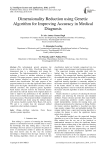
Dimensionality Reduction using Genetic Algorithm for Improving Accuracy in Medical Diagnosis
Статья научная
The technological growth generates the massive data in all the fields. Classifying these high-dimensional data is a challenging task among the researchers. The high-dimensionality is reduced by a technique is known as attribute reduction or feature selection. This paper proposes a genetic algorithm (GA)-based features selection to improve the accuracy of medical data classification. The main purpose of the proposed method is to select the significant feature subset which gives the higher classification accuracy with the different classifiers. The proposed genetic algorithm-based feature selection removes the irrelevant features and selects the relevant features from original dataset in order to improve the performance of the classifiers in terms of time to build the model, reduced dimension and increased accuracy. The proposed method is implemented using MATLAB and tested using the medical dataset with various classifiers namely Naïve Bayes, J48, and k-NN and it is evident that the proposed method outperforms other methods compared.
Бесплатно

